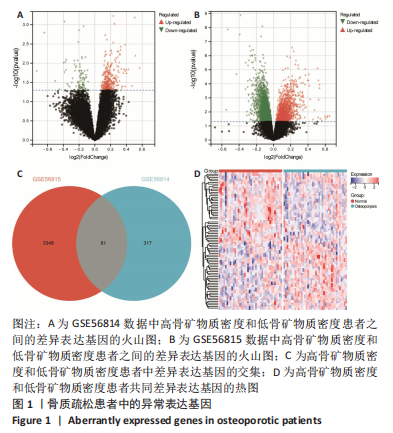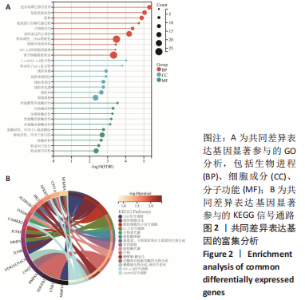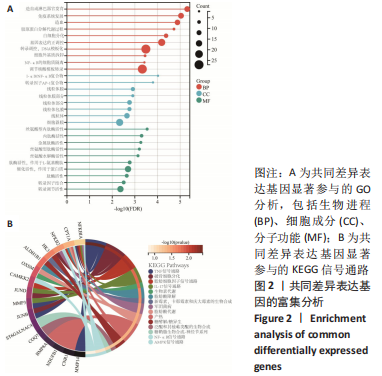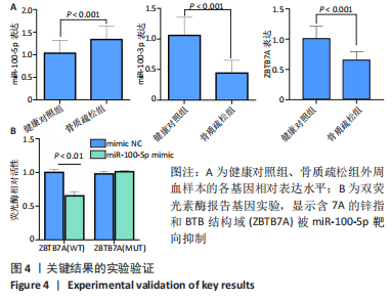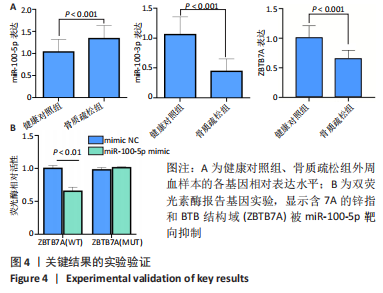Chinese Journal of Tissue Engineering Research ›› 2023, Vol. 27 ›› Issue (32): 5168-5172.doi: 10.12307/2023.843
Previous Articles Next Articles
Has-miR-100-5p targeting zinc finger and BTB domain containing 7A is a potential target for postmenopausal osteoporosis
Maihemutijiang · Muhaimaiti, Maimaitishawutiaji · Maimaiti, Tang Junwei, Zhang Yuxin
- Department of Spinal Orthopedics, the First People’s Hospital of Kashgar, Kashgar 844099, Xinjiang Uygur Autonomous Region, China
-
Received:2022-08-10Accepted:2022-11-18Online:2023-11-18Published:2023-03-23 -
Contact:Zhang Yuxin, Chief physician, Department of Spinal Orthopedics, the First People’s Hospital of Kashgar, Kashgar 844099, Xinjiang Uygur Autonomous Region, China -
About author:Maihemutijiang · Muhaimaiti, Master, Attending physician, Department of Spinal Orthopedics, the First People’s Hospital of Kashgar, Kashgar 844099, Xinjiang Uygur Autonomous Region, China -
Supported by:Kashgar Regional Science and Technology Program Project, No. KS2020008 (to MM)
CLC Number:
Cite this article
Maihemutijiang · Muhaimaiti, Maimaitishawutiaji · Maimaiti, Tang Junwei, Zhang Yuxin. Has-miR-100-5p targeting zinc finger and BTB domain containing 7A is a potential target for postmenopausal osteoporosis[J]. Chinese Journal of Tissue Engineering Research, 2023, 27(32): 5168-5172.
share this article
Add to citation manager EndNote|Reference Manager|ProCite|BibTeX|RefWorks
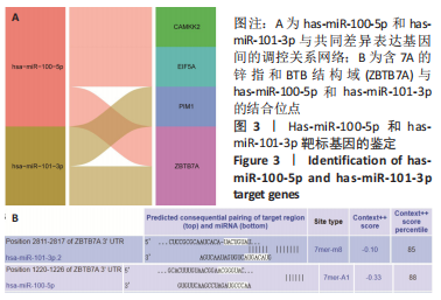
2.3 has-miR-100-5p和has-miR-101-3p靶标基因 通过miRTargetbase数据库和miRTarget数据库预测has-miR-100-5p和has-miR-101-3p 的调控靶标基因,并与共同差异表达基因比较。鉴定了has-miR-100-5p和has-miR-101-3p靶向CAMKK2、EIF5A、PIM1、ZBTB7A的调控网络,见图3A。其中,ZBTB7A同时被has-miR-100-5p和has-miR-101-3p所调控,被认为是关键靶标基因。miRTargetbase数据库中预测的ZBTB7A与has-miR-100-5p和has-miR-101-3p的结合位点,见图3B。"
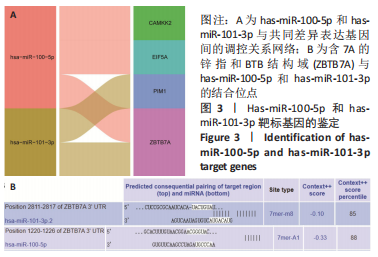
| [1] GREGSON C, ARMSTRONG DJ, BOWDEN J, et al. UK clinical guideline for the prevention and treatment of osteoporosis. Arch Osteoporos. 2022;17(1):1-46. [2] CURTIS EM, Reginster JY, Al-Daghri N, et al. Management of patients at very high risk of osteoporotic fractures through sequential treatments. Aging Clin Exp Res. 2022;34:695-714. [3] ZHANG W, GAO R, RONG X, et al. Immunoporosis: Role of immune system in the pathophysiology of different types of osteoporosis. Front Endocrinol (Lausanne). 2022;13:965258. [4] EASTELL R, O’NEILL TW, HOFBAUER LC, et al. Postmenopausal osteoporosis. Nat Rev Dis Primers. 2016;2(1):1-16. [5] WANG A, ZHANG H, LI G, et al. Deciphering core proteins of osteoporosis with iron accumulation by proteomics in human bone. Front Endocrinol (Lausanne). 2022;13:961903. [6] CRANDALL CJ, VASAN S, LACROIX A, et al. Bone turnover markers are not associated with hip fracture risk: a case‐control study in the Women’s Health Initiative. J Bone Miner Res. 2018;33(7):1199-1208. [7] BROWN JP. Long-term treatment of postmenopausal osteoporosis. Endocrinol Metab (Seoul). 2021;36(3):544. [8] SŁUPSKI W, JAWIEŃ P, NOWAK B. Botanicals in postmenopausal osteoporosis. Nutrients. 2021;13(5):1609. [9] KERSCHAN-SCHINDL K, HACKL M, BOSCHITSCH E, et al. Diagnostic performance of a panel of mirnas (osteomir) for osteoporosis in a cohort of postmenopausal women. Calcif Tissue Int. 2021;108(6):725-737. [10] WANG G, ZHANG L, YAN C, et al. Overexpression of miR125b Promotes Osteoporosis Through miR-125b-TRAF6 Pathway in Postmenopausal Ovariectomized Rats. Diabetes Metab Syndr Obes. 2021;14:671. [11] DE MARTINIS M, GINALDI L, ALLEGRA A, et al. The osteoporosis/microbiota linkage: the role of miRNA. Int J Mol Sci. 2020;21(23):8887. [12] ZHAO Y, JIA L, ZHENG Y, et al. Involvement of noncoding RNAs in the differentiation of osteoclasts. Stem Cells Int. 2020;2020:4813140. [13] AI L, YI W, CHEN L, et al. Xian-Ling-Gu-Bao protects osteoporosis through promoting osteoblast differentiation by targeting miR-100-5p/KDM6B/RUNX2 axis. In Vitro Cell Dev Biol Anim. 2021;57:3-9. [14] WANG R, ZHANG M, HU Y, et al. MiR-100-5p inhibits osteogenic differentiation of human bone mesenchymal stromal cells by targeting TMEM135. Hum Cell. 2022;35(6):1671-1683. [15] LI J, LI Y, WANG S, et al. miR-101-3p/Rap1b signal pathway plays a key role in osteoclast differentiation after treatment with bisphosphonates. BMB Rep. 2019; 52(9):572. [16] HUANG AY, XIONG Z, LIU K, et al. Identification of kaempferol as an OSX upregulator by network pharmacology-based analysis of qianggu Capsule for osteoporosis. Front Pharmacol. 2022;13:1011561. [17] TANG Y, PENG B, LIU J, et al. Systemic immune-inflammation index and bone mineral density in postmenopausal women: A cross-sectional study of the national health and nutrition examination survey (NHANES) 2007-2018. Front Immunol. 2022;13:975400. [18] XU Y, YAN H, ZHANG X, et al. Roles of Altered Macrophages and Cytokines: Implications for Pathological Mechanisms of Postmenopausal Osteoporosis, Rheumatoid Arthritis, and Alzheimer’s Disease. Front Endocrinol (Lausanne). 2022;13:876269. [19] SRIVASTAVA RK, SAPRA L. The Rising Era of “Immunoporosis”: Role of Immune System in the Pathophysiology of Osteoporosis. J Inflamm Res. 2022;15: 1667. [20] WU D, CLINE-SMITH A, SHASHKOVA E, et al. T-cell mediated inflammation in postmenopausal osteoporosis. Front Immunol. 2021;12:2413. [21] CHARATCHAROENWITTHAYA N, KHOSLA S, ATKINSON EJ, et al. Effect of blockade of TNF‐α and interleukin‐1 action on bone resorption in early postmenopausal women. J Bone Miner Res. 2007;22(5):724-729. [22] YANG K, CAO F, XUE Y, et al. Three Classes of Antioxidant Defense Systems and the Development of Postmenopausal Osteoporosis. Front Physiol. 2022;13:840293. [23] LIANG B, BURLEY G, LIN S, et al. Osteoporosis pathogenesis and treatment: existing and emerging avenues. Cell Mol Biol Lett. 2022;27:72. [24] BHATNAGAR A, KEKATPURE AL. Postmenopausal Osteoporosis: A Literature Review. Cureus. 2022;14:e29367. [25] LIU T, HUANG J, XU D, et al. Identifying a possible new target for diagnosis and treatment of postmenopausal osteoporosis through bioinformatics and clinical sample analysis. Ann Transl Med. 2021;9(14):1154. [26] SHAHRIARPOUR Z, NASRABADI B, HEJRI-ZARIFI S, et al. Oxidative balance score and risk of osteoporosis among postmenopausal Iranian women. Arch Osteoporos. 2021;16(1):1-10. [27] XU J, LI M, PEI W, et al. Reduced Circulating Levels of miR-491-5p and miR-485-3p Are Associated with the Occurrence of Vertebral Fractures in Postmenopausal Women with Osteoporosis. Genet Res (Camb). 2022;2022:3838126. [28] PALA E, DENKÇEKEN T. Differentially expressed circulating miRNAs in postmenopausal osteoporosis: a meta-analysis. Biosci Rep. 2019;39(5):BSR20190667. [29] JOHN AA, XIE J, YANG YS, et al. AAV-mediated delivery of osteoblast/osteoclast-regulating miRNAs for osteoporosis therapy. Mol Ther Nucleic Acids. 2022;29: 296-311. [30] SHI H, JIANG X, XU C, et al. MicroRNAs in Serum Exosomes as Circulating Biomarkers for Postmenopausal Osteoporosis. Front Endocrinol (Lausanne). 2022; 13:819056. [31] HAN Y, YANG Q, HUANG Y, et al. Long non-coding RNA SNHG5 promotes the osteogenic differentiation of bone marrow mesenchymal stem cells via the miR-212-3p/GDF5/SMAD pathway. Stem Cell Res Ther. 2022;13:130. [32] GRUNDMANN S, HANS FP, KINNIRY S, et al. MicroRNA-100 regulates neovascularization by suppression of mammalian target of rapamycin in endothelial and vascular smooth muscle cells. Circulation. 2011;123(9):999-1009. [33] Verdelli C, Sansoni V, Perego S, et al. Circulating fractures-related microRNAs distinguish primary hyperparathyroidism-related from estrogen withdrawal-related osteoporosis in postmenopausal osteoporotic women: A pilot study. Bone. 2020;137:115350. [34] WANG R, LU A, LIU W, et al. Searching for valuable differentially expressed miRNAs in postmenopausal osteoporosis by RNA sequencing. J Obstet Gynaecol Res. 2020;46:1183-1192. [35] CARTHEW J, DONDERWINKEL I, SHRESTHA S, et al. In situ miRNA delivery from a hydrogel promotes osteogenesis of encapsulated mesenchymal stromal cells. Acta Biomater. 2020;101:249-261. [36] XIANG J, FU H Q, XU Z, et al. lncRNA SNHG1 attenuates osteogenic differentiation via the miR 101/DKK1 axis in bone marrow mesenchymal stem cells. Mol Med Rep. 2020;22(5):3715-3722. [37] WU P, JIAO F, HUANG H, et al. Morinda officinalis polysaccharide enable suppression of osteoclastic differentiation by exosomes derived from rat mesenchymal stem cells. Pharm Biol. 2022;60(1):1303-1316. [38] AIBAR-ALMAZAN A, VOLTES-MARTINEZ A, CASTELLOTE-CABALLERO Y, et al. Current Status of the Diagnosis and Management of Osteoporosis. Int J Mol Sci. 2022;23(16):9465. [39] DAI Z, WEI G. Inhibition of miRNA-100 facilitates bone regeneration defects of mesenchymal stem cells in osteoporotic mice through the protein kinase B pathway. Bioengineered. 2022;13(1):963-973. [40] ZOU W, IZAWA T, ROHATGI N, et al. ThPOK Inhibits Osteoclast Formation Via NFATc1 Transcription and Function. JBMR Plus. 2022;6:e10613. [41] RAMOS PITTOL JM, ORUBA A, MITTLER G, et al. Zbtb7a is a transducer for the control of promoter accessibility by NF-kappa B and multiple other transcription factors. PLoS Biol. 2018;16:e2004526. [42] CONSTANTINOU C, SPELLA M, CHONDROU V, et al. The multi-faceted functioning portrait of LRF/ZBTB7A. Hum Genomics. 2019;13(1):1-14. |
| [1] | Wu Tianliang, Tao Xiuxia, Xu Hongguang. Influence of different bone mineral densities on cage subsidence after stand-alone oblique lateral interbody fusion: three-dimensional finite element analysis [J]. Chinese Journal of Tissue Engineering Research, 2023, 27(9): 1352-1358. |
| [2] | Liu Hao, Yang Hongsheng, Zeng Zhimou, Wang Liping, Yang Kunhai, Hu Yongrong, Qu Bo. Lumbar MRI vertebral bone quality score to evaluate the severity of osteoporosis in postmenopausal women [J]. Chinese Journal of Tissue Engineering Research, 2023, 27(4): 606-611. |
| [3] | Yang Yunhong, Fan Yinuo, Zhang Jiahao, Zhang Xiangqi, Zhao Xiaofeng, Chen Zhenqiu, Sun Xiaofeng. The relationship between postmenopausal bone mineral density and specific physiological period values in women based on NHANES database [J]. Chinese Journal of Tissue Engineering Research, 2023, 27(32): 5191-5195. |
| [4] | Chen Jianchao, Song Huiping. Distribution characteristics of bone mass in different parts of postmenopausal women with knee osteoarthritis [J]. Chinese Journal of Tissue Engineering Research, 2023, 27(31): 5035-5039. |
| [5] | Gu Peng, Pu Bin, Chen Junbang, Yue Dan, Xin Qiao, Zeng Zhanpeng, Zheng Xiaohui. Correlation between new sarcopenia index and bone mineral density in postmenopausal patients with type 2 diabetes mellitus [J]. Chinese Journal of Tissue Engineering Research, 2023, 27(31): 5009-5014. |
| [6] | Su Hui, Yan Binghan, Wang Ruochong, Xue Haipeng, Tan Guoqing, Xu Zhanwang. Effect of Bushen Zhuanggu Fang on bone metabolism and bone mineral density in rats with ovariectomized osteoporosis [J]. Chinese Journal of Tissue Engineering Research, 2023, 27(28): 4507-4512. |
| [7] | Wang Zhenyu, Xia Yuan, Lu Yue, Pan Xinyong, Li Yongjie. Effects of different resistance training programs on bone mineral density in postmenopausal women: a network Meta-analysis [J]. Chinese Journal of Tissue Engineering Research, 2023, 27(28): 4586-4592. |
| [8] | Lin Shi, Yuan Jiayao, Lin Xiancan, Yang Binbin, Wu Jianjun, Dongzhi Zhuoma, Tang Zijia, Yang Zhijie, Wan Lei, Huang Hongxing. Diagnostic value of peripheral blood interferon-gamma and monocyte chemoattractant protein-1 in postmenopausal osteoporosis [J]. Chinese Journal of Tissue Engineering Research, 2023, 27(2): 165-170. |
| [9] | Jiang Guozheng, Feng Ningning, Yu Xing, Zhao He, Yang Yongdong, Qu Yi, Wang Fengxian. Correlation between hand feeling and torque of screw insertion in lumbar pedicle system [J]. Chinese Journal of Tissue Engineering Research, 2023, 27(18): 2861-2865. |
| [10] | Yin Yuping, Liu Jiachen, Guo Ningning, Li Chuangquan, Liu Xiuwen, Zhang Shukang, Lin Xueqing, Tang Wei, Chen Shaoxiong, Liu Xingguang, Wu Guixia, Li Long, Liu Jing, Zhang Hong. Bone mineral density difference in bilateral femoral necks measured by dual-energy X-ray absorptiometry and its influencing factors [J]. Chinese Journal of Tissue Engineering Research, 2023, 27(13): 2081-2086. |
| [11] | Liu Zhi, Zhu Yong, Lin Zhangyuan, Zhao Ruibo, Long Haitao, Lu Bangbao, Sun Buhua, Cheng Liang, Zhao Shushan. Calcitonin for postmenopausal osteoporotic hip fractures: a prospective randomized controlled trial [J]. Chinese Journal of Tissue Engineering Research, 2023, 27(11): 1739-1743. |
| [12] | Xiao Hao, Liu Jing, Zhou Jun. Research progress of pulsed electromagnetic field in the treatment of postmenopausal osteoporosis [J]. Chinese Journal of Tissue Engineering Research, 2022, 26(8): 1266-1271. |
| [13] | Shen Song, Xu Bin. Diffuse distribution of bone cement in percutaneous vertebroplasty reduces the incidence of refracture of adjacent vertebral bodies [J]. Chinese Journal of Tissue Engineering Research, 2022, 26(4): 499-503. |
| [14] | Zhai Xiao, Yang Xinming, Liu Fanghong, Sun Jianwei. Effect of teriparatide combined with risedronate sodium on bone metabolism in patients with osteoporotic vertebral compression fractures [J]. Chinese Journal of Tissue Engineering Research, 2022, 26(35): 5685-5692. |
| [15] | Xiang Qianru, Deng Xuejian, Chen Huafeng, Liang Jiamin, An Min, Yang Li. Gene-modified stem cells therapy for osteoporosis: a meta-analysis of preclinical studies [J]. Chinese Journal of Tissue Engineering Research, 2022, 26(31): 5053-5061. |
| Viewed | ||||||
|
Full text |
|
|||||
|
Abstract |
|
|||||

